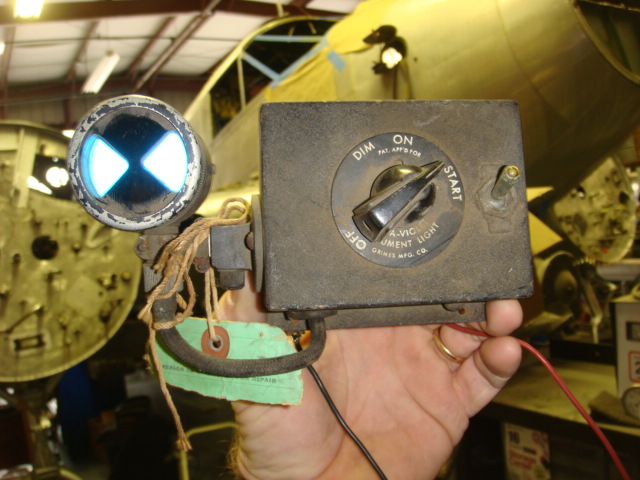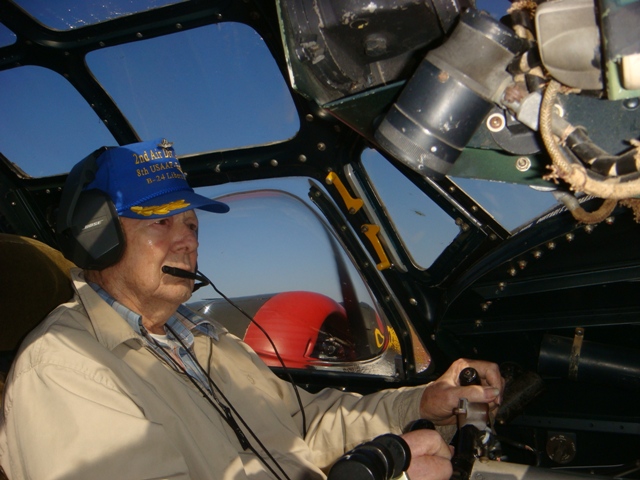B-24 cockpit lighting.
Fri Feb 15, 2008 3:44 pm
I received a message through my Yankee Air Museum e-mail asking for the color of the lights and instruments in the cockpit of a WWII era Bomber. Having never been in "Ol' 927" or "Witchcraft" after dark, I can't help.
So, what color is the interior lighting? Are the dials illuminated?
Kos
So, what color is the interior lighting? Are the dials illuminated?
Kos
Fri Feb 15, 2008 3:53 pm
Ol' 927 utilizes red post lights and some backlighting.
Gary
Gary
Fri Feb 15, 2008 8:17 pm
Most WWII aircraft have instrument lighting provided by small lights, commonly called cockpit lights, mounted on swivel posts. Some lights were mounted on flexible arms that could be positioned around the cockpit.
Early and pre war aircraft instruments may have had radium faces and were illuminated by fluorescent lighting with ultraviolet filters. These lights had high voltage vibrator power supplies and starter circuits. Later fluorescent/UV lights would run straight from aircraft DC power.The control switch/rheostat would have a spring loaded start position to energize the start circuit for the light. After starting the rheostat could be reduced to vary the intensity. On some of these lights the UV filter also could be rotated or removed which would let direct lighting through.
Here is a shot of a UV light here in the shop that I hooked up to 24 volts and fired it up after the rheostat was turned to start. The filter is wide open to allow direct lighting from the fluorescent bulb.

The use of radium faces on instruments seems to have dropped off later in the war. Late aircraft would commonly have simpler cockpit lights that used incandescent bulbs running on regular aircraft DC power. These lights used normal rheostats to vary the intensity. They often had filters, usually red, but could be switched to direct incandescent light by removing the filter or a slide type of arrangement.
I believe that eye brow lights and post lights or individually lighted instruments didn’t become common practice until after WWII. Several different instruments in WWII had their own lighting (compasses for example) but this was more the exception than the norm.
Here is a photo taken of Rowe Bowen, an 89 year young WWII B-24 pilot taking the controls of a B-24J for the first time in over 60 years. I had the distinct honor to fly right seat with him when I took this photo.

In the upper right corner you can see the fluorescent cockpit light and the knob for its rheostat. The wiring for the light is also visible in the photo.
In the lower right side you can barely see the face of another cockpit light rheostat, just like the one above, that shows the start position for the light.
Incidentally Mr. Bowen flew that B-24 better than I ever will! How cool to see him do what he did so beautifully 60 years later.
Early and pre war aircraft instruments may have had radium faces and were illuminated by fluorescent lighting with ultraviolet filters. These lights had high voltage vibrator power supplies and starter circuits. Later fluorescent/UV lights would run straight from aircraft DC power.The control switch/rheostat would have a spring loaded start position to energize the start circuit for the light. After starting the rheostat could be reduced to vary the intensity. On some of these lights the UV filter also could be rotated or removed which would let direct lighting through.
Here is a shot of a UV light here in the shop that I hooked up to 24 volts and fired it up after the rheostat was turned to start. The filter is wide open to allow direct lighting from the fluorescent bulb.

The use of radium faces on instruments seems to have dropped off later in the war. Late aircraft would commonly have simpler cockpit lights that used incandescent bulbs running on regular aircraft DC power. These lights used normal rheostats to vary the intensity. They often had filters, usually red, but could be switched to direct incandescent light by removing the filter or a slide type of arrangement.
I believe that eye brow lights and post lights or individually lighted instruments didn’t become common practice until after WWII. Several different instruments in WWII had their own lighting (compasses for example) but this was more the exception than the norm.
Here is a photo taken of Rowe Bowen, an 89 year young WWII B-24 pilot taking the controls of a B-24J for the first time in over 60 years. I had the distinct honor to fly right seat with him when I took this photo.

In the upper right corner you can see the fluorescent cockpit light and the knob for its rheostat. The wiring for the light is also visible in the photo.
In the lower right side you can barely see the face of another cockpit light rheostat, just like the one above, that shows the start position for the light.
Incidentally Mr. Bowen flew that B-24 better than I ever will! How cool to see him do what he did so beautifully 60 years later.
Fri Feb 15, 2008 8:39 pm
Taigh Ramey wrote:
Here is a photo taken of Rowe Bowen, an 89 year young WWII B-24 pilot taking the controls of a B-24J for the first time in over 60 years. I had the distinct honor to fly right seat with him when I took this photo.
Incidentally Mr. Bowen flew that B-24 better than I ever will! How cool to see him do what he did so beautifully 60 years later.
I think that is so awesome to see these WWII vets get to fly in planes like they did when they were younger.
Fri Feb 15, 2008 11:26 pm
Thanks for sharing that story and picture, Taigh.
I love being able to see how "young" veterans look when they are around their combat machines today. Sixty years seem to vanish into thin air. My personal favorite thing to do is talk mechanic/maintenance stuff with guys who were mechanics during the war. I always get a feeling that I'm somehow invited to go back with them to their youth and the experiences they went through. As a bonus, things were often just as SNAFU for them as it is where I work today!
Scott
I love being able to see how "young" veterans look when they are around their combat machines today. Sixty years seem to vanish into thin air. My personal favorite thing to do is talk mechanic/maintenance stuff with guys who were mechanics during the war. I always get a feeling that I'm somehow invited to go back with them to their youth and the experiences they went through. As a bonus, things were often just as SNAFU for them as it is where I work today!
Scott
Sat Feb 16, 2008 2:21 am
Geez, that's cool. Screw the rheostat, look at that guy fly! 
How amazing! Thanks for sharing the bird and the photo. God bless these heros.
How amazing! Thanks for sharing the bird and the photo. God bless these heros.
B-24 Lighting
Thu Feb 21, 2008 4:26 pm
Taigh,
Thanks for the very detailed info. I'll pass that along.
Kos
Thanks for the very detailed info. I'll pass that along.
Kos
Thu Feb 21, 2008 4:53 pm
Touching shot.
Thu Feb 21, 2008 5:26 pm
That rules. You're lucky to get experience moments like that.
Thu Feb 21, 2008 5:35 pm
I know the light colors are important but that picture (as they say) is worth a 1000 words.
Thu Feb 21, 2008 8:46 pm
The most rewarding thing about messing around with Warbirds is being able to do what you see in the photo above. I feel very fortunate to have been able to help a lot of WWII vets re live their wartime experiences one more time. There are many more projects planned to get these folks back up doing what they used to do and it is a delight to witness them.
When the question about cockpit lights came up I thought of that photo and figured it was a good excuse to post the shot. I took several shots of him on that flight and a video but this was by far the shot that captured the moment. It was something to see him get into the groove and handle that B-24 like he had flown it just the day before. I am still learning to fly the Liberator and my dream is that someday I might be able to handle her just a fraction as good as Mr. Bowen did.
Life is pretty good, especially that day! I want to thank Jim Goolsby for puting Mr Bowen up in the cockpit next to me. Jim is an awesome B-24 pilot and is also one of the few people around who has a Navigators rating. Thanks Jim and Rob for the ongoing awesome opportunities.
When the question about cockpit lights came up I thought of that photo and figured it was a good excuse to post the shot. I took several shots of him on that flight and a video but this was by far the shot that captured the moment. It was something to see him get into the groove and handle that B-24 like he had flown it just the day before. I am still learning to fly the Liberator and my dream is that someday I might be able to handle her just a fraction as good as Mr. Bowen did.
Life is pretty good, especially that day! I want to thank Jim Goolsby for puting Mr Bowen up in the cockpit next to me. Jim is an awesome B-24 pilot and is also one of the few people around who has a Navigators rating. Thanks Jim and Rob for the ongoing awesome opportunities.